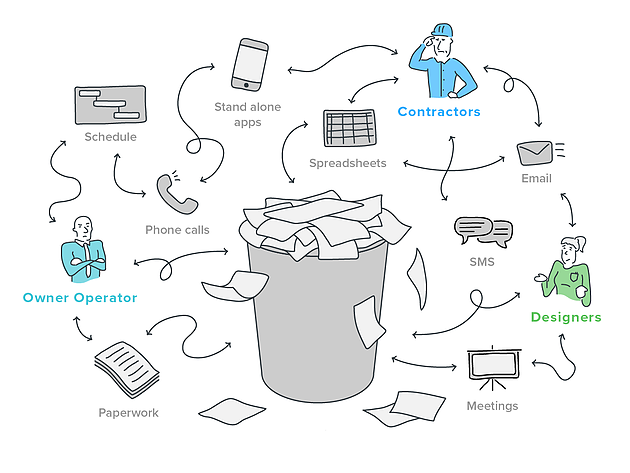Effective Construction Document Management Solutions for each Job
Effective Construction Document Management Solutions for each Job
Blog Article
Optimizing Project Collaboration: Architect's Finest Practices in Building And Construction Document Monitoring
In the intricate realm of architectural jobs, the reliable monitoring of construction files stands as a foundation for success. Among this complexity lies an important inquiry: how can designers streamline partnership procedures to improve task outcomes?
Leveraging Cloud-Based Systems
By transitioning from standard paper-based systems to shadow options, designers can streamline partnership, enhance paper availability, and enhance total task performance. This availability promotes seamless interaction and control among job stakeholders, leading to fewer errors and hold-ups in the building procedure.
Furthermore, cloud-based platforms offer a protected setting for storing delicate project details, offering encryption, regular back-ups, and customer permission setups to protect data honesty. Designers can additionally benefit from the scalability of cloud solutions, permitting them to change storage capability and functionality based on project demands. Overall, leveraging cloud-based platforms encourages engineers to optimize their construction document monitoring procedures, driving higher collaboration, performance, and success in their projects.
Implementing Variation Control Systems
Having actually developed the advantages of cloud-based platforms in building record management, architects can now improve their record control processes by executing Variation Control Systems. Version Control Equipment (VCS) are crucial tools that track modifications in documents, ensuring that team members are constantly collaborating with the latest and most precise info. By implementing VCS, architects can preserve a central database where all project papers are stored, making it possible for seamless cooperation while minimizing the danger of mistakes and version disputes.
One key advantage of Variation Control Systems is the capacity to track the complete history of document modifications, permitting users to return to previous variations if needed (construction document management). This function is specifically valuable in building jobs where layout models and modifications prevail. Additionally, VCS helps with better interaction among staff member by offering a clear audit trail of that made details modifications and when they were made. This openness not only enhances liability however additionally assists in fixing disputes or disparities that may arise throughout the project lifecycle.
Establishing Communication Methods
To make sure efficient and efficient project sychronisation, engineers should develop clear and durable communication procedures within their building and construction file monitoring processes. Interaction protocols specify the methods, regularity, and networks where staff member exchange info, updates, and feedback. One vital facet of establishing these methods is identifying a central communication platform where all project-related conversations and document sharing can happen. This system can be a project administration software application, email strings, or cloud-based storage solutions. By setting standards on just how details is shared and exactly how staff member connect with each other, architects can enhance the flow of information and avoid miscommunications or hold-ups in the building and construction procedure.
Furthermore, interaction protocols must additionally consist of standards on exactly how to deal with conflicts, modification orders, and immediate issues that might develop during the task lifecycle. Developing a structured technique to communication makes sure that all stakeholders are on the exact same page, promotes openness, and eventually adds to the successful conclusion of the building job.
Utilizing BIM Software for Control
BIM software application plays a critical role in boosting sychronisation among task employee in the building market. Building Info Modeling (BIM) helps with collaboration by providing a central system where engineers, designers, contractors, and other stakeholders can collaborate in a coordinated way. Via BIM software, project participants can access and upgrade a shared model which contains in-depth details about the structure design, building and construction parts, and job routines.

Furthermore, BIM software program makes it possible for real-time partnership and interaction among group participants, despite their physical location. Through cloud-based BIM systems, job stakeholders can access the most up to date job information, track changes, and make informed decisions quickly. In general, leveraging BIM software for coordination boosts job efficiency, productivity, and ultimately causes successful task end results.
Ensuring Data Security and Conformity
In the world of building and construction file monitoring, safeguarding data honesty and ensuring regulative conformity are critical considerations for engineers and other job stakeholders. Architects need to implement durable security procedures to safeguard delicate project details from unapproved access or breaches.

Verdict
To conclude, engineers can enhance task partnership in construction paper monitoring by leveraging cloud-based platforms, implementing variation control systems, establishing interaction protocols, using BIM software program for coordination, and making certain data protection and compliance. These finest techniques help enhance the construction process, enhance interaction among job stakeholders, and boost effectiveness in task distribution. By complying with these standards, architects can successfully manage building and construction documents and assist in successful task end results.
Through BIM software program, job individuals can access and update a common model that consists of detailed info about the building style, building and construction components, and project routines.
Via cloud-based BIM platforms, project stakeholders can access the latest job details, track changes, and make informed decisions immediately - construction document management. Generally, leveraging BIM software program for coordination enhances project efficiency, productivity, and eventually leads try these out to successful job results
In final thought, engineers can maximize task cooperation in building and construction record monitoring by leveraging cloud-based platforms, executing version control systems, establishing communication methods, utilizing BIM software program for sychronisation, and making sure information protection and conformity. These ideal methods assist streamline the construction procedure, boost interaction among task stakeholders, and improve efficiency in project distribution.
Report this page